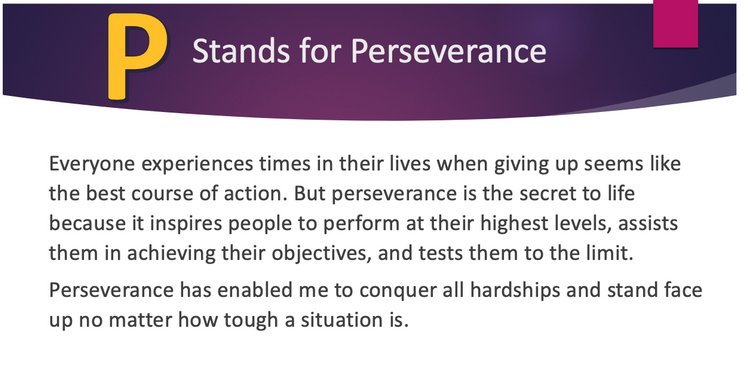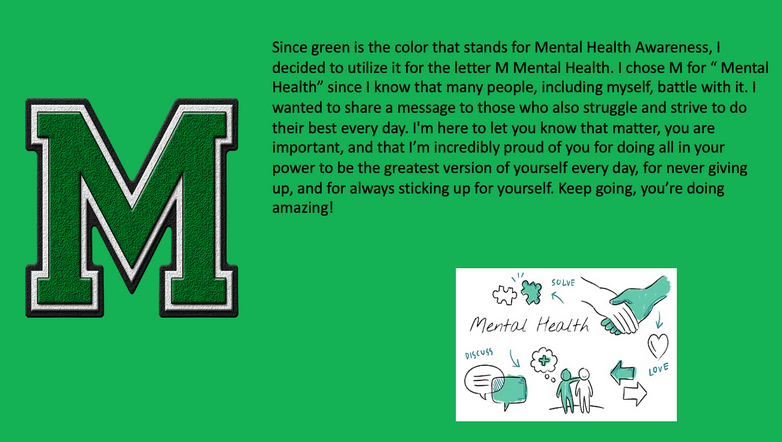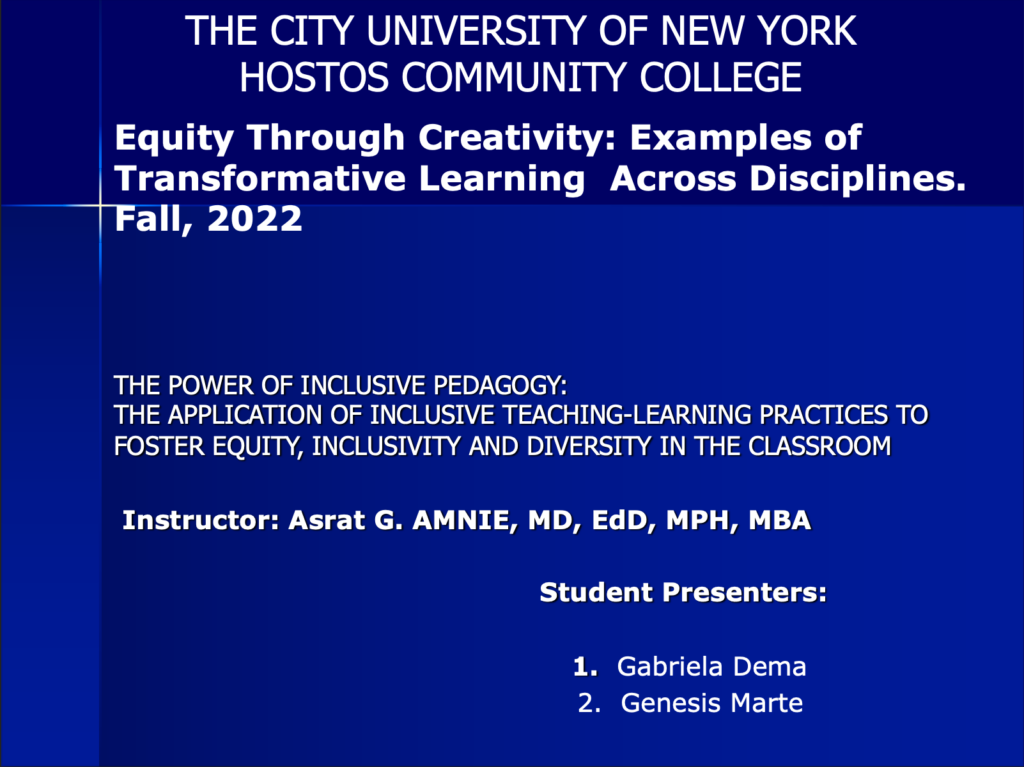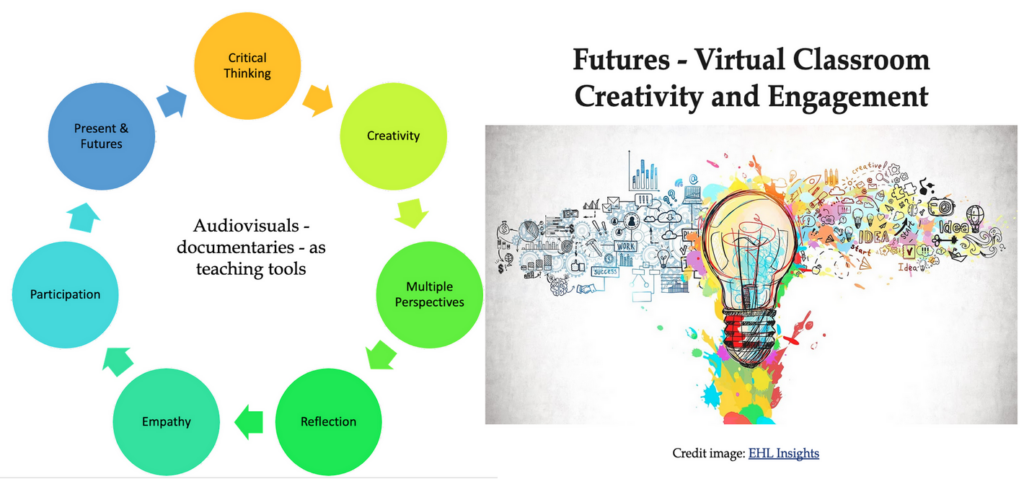We had the opportunity to present the workshop Equity through Creativity: Examples of Transformative Teaching Across the Disciplines, in which each of our colleagues and their students collaborated in multiple ways. The main goal of this workshop was to highlight, communicate, and share the ways in which we engage with our students in the classroom, particularly using multiple creative outlets, such as visual arts, film and documentaries, inclusive pedagogy/teaching, and literacy narrative. Our workshop brought experiences centered in multidisciplinary approaches, and student-centered pedagogy, with the ultimate goals of fostering equity, inclusivity, and critical thinking when centering student voices in our classrooms.

Prof. Noëlle Warden King (Department of Art & Music, Bronx Community College) presented an artistic project that centers the creativity, voice, and joy of students in her classroom. The project 3 Letters of My Alphabet showcases the students and that which is of great importance to them. Each student chooses 3 letters (not limited to the English alphabet) that are the first letter of a word of significance to them. They then make a short PowerPoint of four slides; the first a self-introduction, followed by their three letters and a short paragraph explaining the meaning of each word for them. Some of the samples of their projects can be found in this short blog post.


Dr. Stephanie Hershinow (Department of English, Baruch College) shared at the workshop an assignment she provides students with in her class so they can get to know each other better, to make them feel valued as individuals, and to teach them writing. This assignment is a literacy narrative—a common assignment in many first year writing classrooms. Since 2018, Dr. Hershinow has centered the First Year Writing course on Mary Shelley’s Frankenstein – highlighting the history and theory of the novel, and 2018 marked its 200th anniversary, resulting in a trove of fascinating responses and connections to contemporary events that Dr. Hershinow has been able to take advantage of her course. For their first assignment, students write an analysis of the novel, and the second assignment asks them to think of the novel more as inspiration. Many of the students wrote about their lives, their families, and their heritage. Dr. Hershinow shared in the workshop the audio clip recordings of students reading their inspiring essays.

Image obtained on Flickr
Dr. Asrat Amnie (Department of Education, Hostos Community College) presented The Power of Inclusive Pedagogy: The Application of Inclusive Teaching-Learning Practices To Foster Equity, Inclusivity, and Diversity in the Classroom. Dr. Amnie described his inclusion of TLH principles in the courses he taught this semester: curricular revisions, intentionality of including diverse set of materials in his course (multimedia), OER textbooks, among other adaptations. The instructor made sure the course reflects historical and current perspectives of diverse societies about addiction (War on Drugs, racial disparities on the criminal justice system, among other important societal issues). Dr. Amnie also highlighted other aspects that demonstrate the inclusion of aspects that fostered equity, and a comprehensive classroom: person-first language, online etiquette, and using Blackboard Ally, which helped increase accessibility to alternate versions of the course materials. All these aspects fostered an inclusive environment, which resulted in higher student-faculty participation in the course.

Prof. Joseph A. Torres-González (Department of Anthropology, Brooklyn College) presented Documentaries, Videos, and Podcasts: Fostering critical thinking & creativity in the virtual classroom. Prof. Torres-González highlighted how he used audiovisual materials – documentaries, videos, podcasts – and Open Educational Resources (OER) to foster critical thinking and creativity. He mentioned how he integrates multimedia as a teaching tool in relationship to the themes discussed during the semester. Audiovisual resources present opportunities to foster critical thinking, engage in creativity and reflection, along with providing a space to create empathy, and having a voice about present and future. One student mentioned: ““The documentaries we have watched in class this semester […] allowed me to better see a variety of topics through other people’s perspectives.”




Comparing Traditional and Modern Building Materials: Which is Best for Your Project?
The construction industry is constantly evolving, and choosing the right materials is one of the most important decisions in any construction project. Today, with the advent of modern materials, many builders and engineers are faced with the dilemma of choosing between traditional materials such as brick, stone, and wood and modern materials such as lightweight concrete, Heplex blocks, and composites. In this article, we will compare these two categories of materials and examine the advantages and disadvantages of each. Finally, we will provide practical guidance for choosing the best option.